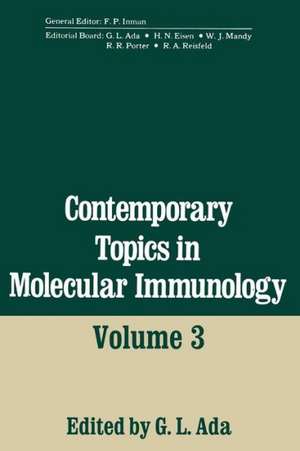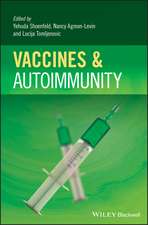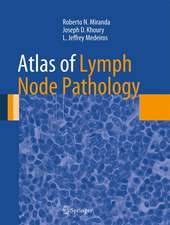Contemporary Topics in Molecular Immunology: Volume 3
Editat de Gordon Adaen Limba Engleză Paperback – 19 mar 2012
Preț: 367.07 lei
Preț vechi: 386.39 lei
-5% Nou
Puncte Express: 551
Preț estimativ în valută:
70.26€ • 76.34$ • 59.06£
70.26€ • 76.34$ • 59.06£
Carte tipărită la comandă
Livrare economică 21 aprilie-05 mai
Preluare comenzi: 021 569.72.76
Specificații
ISBN-13: 9781468428407
ISBN-10: 1468428403
Pagini: 280
Ilustrații: XIV, 260 p.
Dimensiuni: 152 x 229 x 15 mm
Greutate: 0.38 kg
Ediția:Softcover reprint of the original 1st ed. 1974
Editura: Springer Us
Colecția Springer
Locul publicării:New York, NY, United States
ISBN-10: 1468428403
Pagini: 280
Ilustrații: XIV, 260 p.
Dimensiuni: 152 x 229 x 15 mm
Greutate: 0.38 kg
Ediția:Softcover reprint of the original 1st ed. 1974
Editura: Springer Us
Colecția Springer
Locul publicării:New York, NY, United States
Public țintă
ResearchCuprins
The Generation of Antibody Diversity: Its Dependence on Antigenic Stimulation.- I. Introduction.- II. Explanation of the Theory.- III. Changes in the Patterns of Antibody Produced during the Course of an Immune Response.- IV. Numbers of B Cells.- V. Studies on Single Clones.- VI. Genetic Control of Antibody Production.- VII. Self-Tolerance.- VIII. Experimental Approaches.- IX. Discussion.- X. Summary.- Acknowledgments.- References.- Preparation and Properties of Lymphocyte Plasma Membrane.- I. Introduction.- II. Isolation of Plasma Membrane.- III. Properties of Plasma Membrane.- IV. Summary.- Acknowledgment.- References.- Immunogenicity In Vitro: Structural Correlation.- I. Introduction.- II. Direct Stimulation of B Cells.- III. Structure–Activity Relationships.- IV. A Special Example of Thymus-Independent Antigens — Antigen Bound to Macrophages via IgT.- V. Can Nonpolymeric Antigens Induce B-Cell Responses?.- VI. Relationship of B-Cell Differentiation to Induction.- VII. Relationship of Epitope Density to the Induction of Immunity and Tolerance.- VIII. Discussion.- IX. Abbreviations.- References.- mRNA for H and L Chains of Immunoglobulin: Specific Control of H-Chain Production.- I. Introduction.- II. L-Chain mRNA.- III. H-Chain mRNA.- IV. Nuclear Precursor of H-Chain mRNA.- V. Translational Control of H-Chain Synthesis.- VI. Specificity and Nature of H2L2 Interaction with H-Chain mRNA.- VII. Concluding Remarks.- References.- The J Chain of Polymeric Immunoglobulins.- I. Introduction.- II. Class Distribution.- III. Species Distribution.- IV. Detection of J Chain.- V. Isolation of J Chain.- VI. Physical-Chemical Properties.- VII. Chemical Composition.- VIII. Stoichiometry.- IX. Site of J-Chain Attachment.- X. The Requirement for J Chain by IgM Molecules.- XI.Cellular Origin of J Chain.- XII. The Assembly of Polymeric Immunoglobulins.- Acknowledgment.- References.- Phylogenetic Aspects of Immunoglobulin Variable Region Diversity.- I. Introduction.- II. Variable Region Subgroups.- Acknowledgments.- References.- Separation Methods for Lymphocyte Populations.- I. Introduction.- II. Preliminary Steps: Preparation of Clean Cell Suspensions.- III. Separation Based on the Physical Parameters of Cells.- IV. Adherence Separation of Lymphocytes and Phagocytes.- V. Separation Based on Specific Cell Surface Receptors and Antigens.- VI. Electronic Cell Sorting.- References.- Radioelectrocomplexing: A General Radioimmunoassay Procedure for the Detection of Primary Binding of Antigen by Antibody.- I. Introduction.- II. Materials and Methods.- III. Quantitative Studies.- IV. Applications of Radioelectrocomplexing.- V. Summary and Conclusions.- Acknowledgments.- References.











